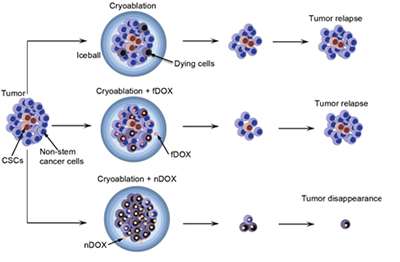Researchers combine cryoablation and nanoparticle-encapsulated anticancer drug to destroy cancer stem-like cells

Combining nanodrug-based chemotherapy and cryoablation provides an effective strategy to eliminate cancer stem-like cells (CSCs) the root of cancer resistance and metastasis, which will help to improve the safety and efficacy of treating malignancies that are refractory to conventional therapies.
Cryoablation (also called cryosurgery or cryotherapy) is an energy-based, minimally invasive surgical technique that has been investigated to treat a variety of diseases including cancer, which is done by freezing the diseased tissue to subzero temperature to induce irreversible damage. It is particularly attractive for fighting against breast cancer due to its excellent cosmetic outcome to preserve the organ with unnoticeable scar formation on skin. However, cryoablation alone has limited effectiveness on eradicating cancer stem-like cells (CSCs), which may lead to cancer recurrence and/or metastasis post operation. A team of researchers from the Department of Biomedical Engineering and Comprehensive Cancer Center at The Ohio State University introduced an innovative strategy by combining cryoablation with nanoparticle-medicated chemotherapy and demonstrated that the combined therapy can significantly augment the destruction of CSCs, resulting in eliminating nearly all CSCs. This technology provides a new approach to overcome drug resistance of CSCs and improve the safety and efficacy of cancer cryoablation. The report appears in the latest issue of the journal Technology.
"This novel combined therapy of cryoablation and nanodrug is a significant step forward in improving the safety and efficacy of fighting against cancer. Our study provides the first account of minimizing cancer recurrence by destroying the cancer stem-like cells in the field of cryoablation for cancer treatment." said Xiaoming He, Ph.D., of The Ohio State University and senior author of this paper. "It is valuable to facilitate the clinical applications of cryoablation by eliminating the root of cancer resistance ? the cancer stem-like cells".
"The nanoparticles used in this study were optimized for effective drug delivery." said Wei Rao, Ph.D., the lead author of the paper. According to the researchers, an optimized size of the nanodrug facilitates its uptake by cancer cells via endocytosis. A positively charged nanodrug has high electrostatic affinity to the negatively charged cell plasma membrane, which should further facilitate its uptake by cancer cells. Moreover, materials on the nanoparticles have high affinity to CD44 that is one of the common protein complexes overexpressed on cancer stem-like cells. Therefore, the use of nanodrug can help to achieve much-enhanced bioavailability of anticancer drug to cancer stem-like cells compared to conventional chemotherapy using free drug. This particularly attractive feature meets the demand of targeted delivery and therapy and could minimize the drug systemic toxicity. Its combination with cryoablation can significantly augment cryoinjury to ensure complete destruction of all cancer stem-like cells.
Currently, research on the combined therapy of cryoablation and nanodrug showed promising results using 3D mammosphere model at the microscale. Future research will focus more on in vivo studies to monitor tumor relapse after the combined treatment and further translate this technology into the clinic. Although more research is required to ascertain its safety and efficacy, this study provides a novel strategy of combining cryoablation and nanodrug that demonstrates great potential to eliminate cancer from its root ? the cancer stem-like cells.
More information: The paper can be found in the Technology journal.: www.worldscientific.com/doi/ab … 42/S2339547814500022
Provided by World Scientific
















